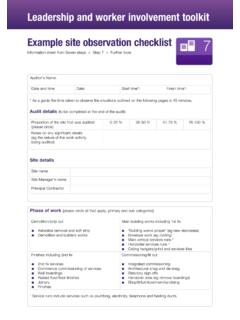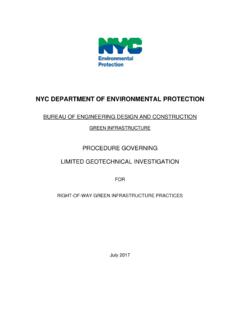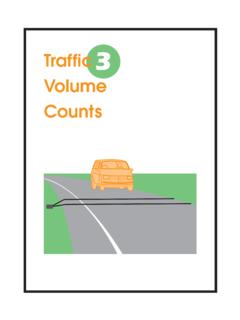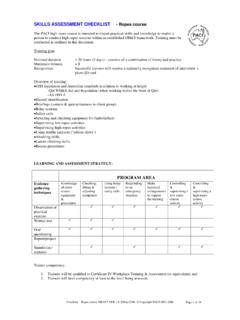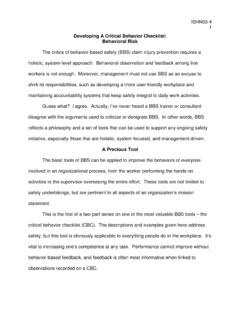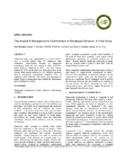Transcription of Standards and Practices for Forecasting
1 Principles of Forecasting : A Handbook for Researchers and Practitioners, J. Scott Armstrong (ed.): Norwell, MA: Kluwer Academic Publishers, 2001 Standards and Practices for Forecasting J. Scott Armstrong The Wharton School, University of Pennsylvania ABSTRACT One hundred and thirty-nine principles are used to summarize knowledge about Forecasting . They cover formulating a problem, obtaining information about it, selecting and applying methods, evaluating methods, and using forecasts. Each principle is described along with its purpose, the conditions under which it is relevant, and the strength and sources of evidence. A checklist of principles is provided to assist in auditing the Forecasting process. An audit can help one to find ways to improve the Forecasting process and to avoid legal liability for poor Forecasting . When managers receive forecasts, they often cannot judge their quality.
2 Instead of focusing on the forecasts, however, they can decide whether the Forecasting process was reasonable for the situation. By examining Forecasting processes and improving them, managers may increase accuracy and reduce costs. One can examine the Forecasting processes by systematically judging it against the 139 Forecasting principles presented. These principles, organized into 16 categories, cover formulating problems, obtaining information, implementing methods, evaluating methods, and using forecasts. Why do you need 139 principles? You will not need all of them in any one situation. Nearly all of the principles are conditional on the characteristics of the situation. It would be misleading to write a book on The Five Principles Used by Successful Forecasters. They could never be appropriate for all the different situations that can arise. The principles were drawn primarily from the papers in Principles of Forecasting .
3 They include the major principles, but ignore some that are specific only to a certain Forecasting method. To help ensure that the principles are correct, this paper was subjected to extensive peer review over a period of three years. The paper was also posted in full text on the Forecasting Principles website with a plea for comments. There were over 36,000 visitors to the site during the three years and helpful suggestions were received. Twenty experts provided careful reviews, and suggestions were obtained when versions of the paper were presented at five academic conferences. I describe the strength of evidence for each principle and provide sources of empirical evidence. Many of the Forecasting principles are based on expert opinion. I use the term common sense when it is difficult to imagine that things could be otherwise. Received wisdom indicates that the vast majority of experts agree.
4 Forecasters often ignore common sense and received wisdom. This observation was reinforced when I presented early versions of the principles to practitioners at the International Association of Business Forecasters in Philadelphia in 1997 and to academics at the Judgmental Inputs to the Forecasting Process conference at University College London in 1998. At both meetings, respondents to a questionnaire agreed with a vast majority of the principles, but they reported that few of these principles were followed in practice. PRINCIPLES OF Forecasting 2 FORMULATING THE PROBLEM 1. Setting Objectives Specify the objectives in the situation, then consider what decisions relate to reaching those objectives. The issues in this section can help to decide whether it is worthwhile to use formal procedures to make forecasts. Describe decisions that might be affected by the forecasts. Description: Analysts should examine how decisions might vary depending on the forecast.
5 Purpose: To improve the use of forecasts by relating them to decision making. Conditions: Forecasts are needed only when they may affect decision making. If there are no decisions to be made, then there is no economic justification to do Forecasting . Or, if the decision has already been made and cannot be changed, there is no need to make forecasts. Ignore this principle if the forecasts are strictly for entertainment, as with election-night forecasts. Strength of evidence: Common sense. Source of evidence: See Fischhoff (2001) for related evidence. Prior to Forecasting , agree on actions to take assuming different possible forecasts. Description. One approach is to ask decision makers to describe what forecasts will change their decisions. Another is to present alternative possible forecasts and ask what decisions they would make. For example, If the forecast is less than 100, we cancel the project.
6 If it is between 100 and 149, we get more information. If it is 150 or more, we continue. Griffith and Wellman (1979) showed that independent quantitative forecasts of bed needs, obtained without prior agreement about how to use them, were ignored by hospital administrators when the forecasts were not to their liking. Purpose: To improve the use of Forecasting . Conditions: Forecasts are needed only when they may affect decision making. Strength of evidence: Common sense. Source of evidence: None. Make sure forecasts are independent of politics. Description. Separate the Forecasting process from the planning process. One possibility is to have one group do the Forecasting and another do the planning. Separating these functions could lead to different reports such as ones showing forecasts for alternative plans. This principle is sensible and important, yet it is often ignored. This is not surprising.
7 Consider, for example, that you received a forecast that the passage of right-to-carry gun laws in the would have beneficial effects, such as reduced deaths. Would you consider that forecast in deciding how to vote on this issue? Purpose: To improve the use of forecasts by reducing bias. Conditions: Impartial forecasts are especially important when they imply major changes. Strength of evidence: Common sense. Standards AND Practices FOR Forecasting 3 Source of evidence: Fildes and Hastings (1994), Griffith and Wellman (1979), Harvey (2001), Larwood and Whittaker (1977), and Sanders and Ritzman (2001). Consider whether the events or series can be forecasted. Description. Would using formal Forecasting procedures produce better forecasts than the current procedure or a naive benchmark? For example, short-term forecasts of the stock market do not improve accuracy (unless they are based on inside information).
8 Purpose: To reduce costs by avoiding useless Forecasting efforts. Conditions: When prior research shows that an area is unlikely to benefit, avoid formal Forecasting . Use it, however, when formal Forecasting produces accuracy equivalent to the current method but at a lower cost. Strength of evidence: Strong empirical support. Source of evidence: Much evidence shows that forecasters cannot beat the stock market with respect to accuracy. This goes as far back as Cowles (1933) and has continued ever since. Obtain decision makers agreement on methods. Description. Describe how the forecasts are to be made, and do so in intuitive terms. Do the decision makers agree that they make sense? It may help to propose using a Forecasting method on an experimental basis. Purpose: Agreement can improve the use of forecasts. Acceptance of the forecasts is more likely if decision makers believe the procedures are relevant.
9 Conditions: The decision makers acceptance of Forecasting methods is important when they control the use of the forecasts. Strength of evidence: Some empirical evidence. Source of evidence: Research on organizational behavior supports this principle, and implementing this principle proved useful in a laboratory experiment (Armstrong 1982). 2. Structuring the Problem The problem should be structured so the analyst can use knowledge effectively and so that the results are useful for decision making. Identify possible outcomes prior to making forecasts. Description. Brainstorming about possible outcomes helps in structuring the approach. For example, experts might be asked to brainstorm the possible outcomes from the imposition of an affirmative action plan in a workplace. Purpose: To improve accuracy. Conditions: Determining possible outcomes is especially important for situations in which the outcomes are not obvious or in which a failure to consider a possible outcome might bias the forecast.
10 Strength of evidence: Indirect evidence. Source of evidence: Tiegen (1983) shows how the specification of outcomes can affect predictions. For example, as new outcomes are added to a situation, forecasters often provide probabilities that exceed 100 percent. Arkes (2001) summarizes evidence relevant to this issue. PRINCIPLES OF Forecasting Tailor the level of data aggregation (or segmentation) to the decisions. Description. Decision makers should help to determine the need for forecasts specified by time, geography, or other factors. One can make forecasts, however, for various components that can then be aggregated or disaggregated to fit the decision needs. Thus, the analyst can focus on the level of aggregation that yields the most accurate forecasts. Purpose: To improve the use of forecasts by tailoring them to decisions. Conditions: Sufficient data must exist to enable different levels of aggregation.

